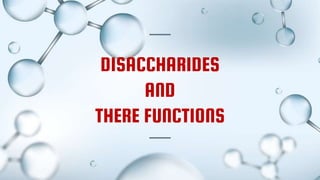
Disaccharides and there function.pptx
- 2. Disaccharides are those carbohydrates that on hydrolysis with acids or enzymes give two molecules of monosaccharides which can either be the same or different. The oxide linkage is formed after the loss of the water molecule and then the two monosaccharides are formed by that linkage. When two monosaccharide units are joined via the oxygen atom then that linkage is called a glycosidic linkage. What are Disaccharides?
- 3. There are two functionally different classes of disaccharides: Reducing disaccharides, in which one monosaccharide, the reducing sugar of the pair, still has a free hemiacetal unit that can perform as a reducing aldehyde group; lactose, maltose and cellobiose are examples of reducing disaccharides, each with one hemiacetal unit, the other occupied by the glycosidic bond, which prevents it from acting as a reducing agent. They can easily be detected by the Woehlk test or Fearon's test on methylamine. Non-reducing disaccharides, in which the component monosaccharides bond through an acetal linkage between their anomeric centers. This results in neither monosaccharide being left with a hemiacetal unit that is free to act as a reducing agent. Sucrose and trehalose are examples of non-reducing disaccharides because their glycosidic bond is between their respective hemiacetal carbon atoms. The reduced chemical reactivity of the non-reducing sugars in comparison to reducing sugars, may be an advantage where stability in storage is important. Classification
- 4. Formation The formation of a disaccharide molecule from two monosaccharide molecules proceeds by displacing a hydroxy group from one molecule and a hydrogen nucleus (a proton) from the other, so that the now vacant bonds on the monosaccharides join the two monomers together. Because of the removal of the water molecule from the product, the term of convenience for such a process is "dehydration reaction" (also "condensation reaction" or "dehydration synthesis"). For example, milk sugar (lactose) is a disaccharide made by condensation of one molecule of each of the monosaccharides glucose and galactose, whereas the disaccharide sucrose in sugar cane and sugar beet, is a condensation product of glucose and fructose. Maltose, another common disaccharide, is condensed from two glucose molecules. The dehydration reaction that bonds monosaccharides into disaccharides (and also bonds monosaccharides into more complex polysaccharides) forms what are called glycosidic bonds
- 5. Structure of Disaccharides (Sucrose) The most common disaccharide is sucrose which gives D -(+)- glucose and D-(-)- fructose on hydrolysis. Both the monosaccharides i.e. glucose and fructose are connected through the glycosidic linkage between alpha glucose and second carbon beta fructose. Sucrose is a non- reducing sugar as both the reducing groups of glucose and fructose are involved in the glycosidic bond formation.
- 6. Examples of Disaccharides 1. Sucrose Sucrose being dextrorotatory in nature gives dextrorotatory glucose as well as laevorotatory fructose on hydrolysis. The overall mixture is laevorotatory and this is because the laevorotation of fructose (-92.4) is more than the dextrorotation of glucose (+52.5).
- 7. 2. Maltose Maltose is also one of the disaccharides which have two α -D-glucose units which are connected by the first carbon of the glucose and also linked to the fourth carbon of another glucose unit. In the solution, a free aldehyde can be produced at the first carbon of the second glucose of the solution and it is a reducing sugar as it shows reducing properties.
- 8. 3. Lactose Commonly it is called milk sugar as this disaccharide is found in milk. It is made up of Beta-D-galactose and β-D-glucose. The bond is between the first carbon of galactose and the fourth carbon of glucose. This is also a reducing sugar.
- 9. Some More Types of Disaccharides There few more types which are not that popular, such as: Trehalose It is made up of 2 molecules of glucose which are linked differently. This can be found in fungi, plants, and insects. Lactulose It is formed from galactose and fructose. It is helpful for the treatment of constipation and liver diseases. Cellobiose It is also made up of two glucose molecules which are also arranged differently. These can be seen bacteriology which is a form of chemical analysis. Chitobiose It comprises two glucosamine molecules which are linked. It is seen in some bacteria, exoskeletons of insects and is also found in fish, octopus, and squid.
- 10. What function do disaccharides serve in the body?
- 11. Disaccharides act as an energy source for the body, just like any other carbohydrate. When we eat foods that contain disaccharides, our bodies break them down into simple sugars (monosaccharides) for absorption in the small intestine
- 12. THANKS!